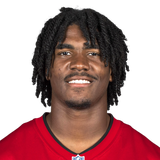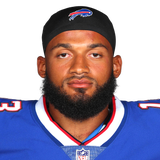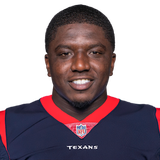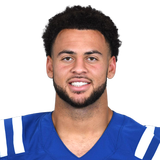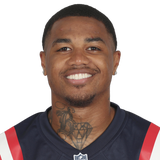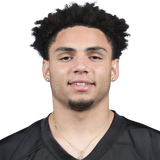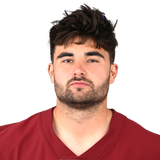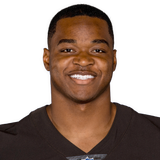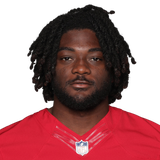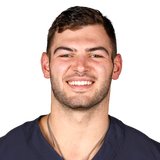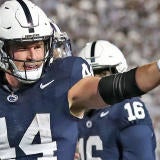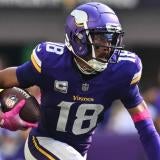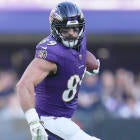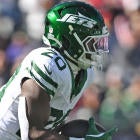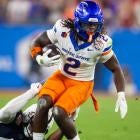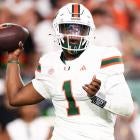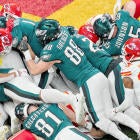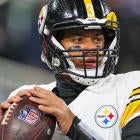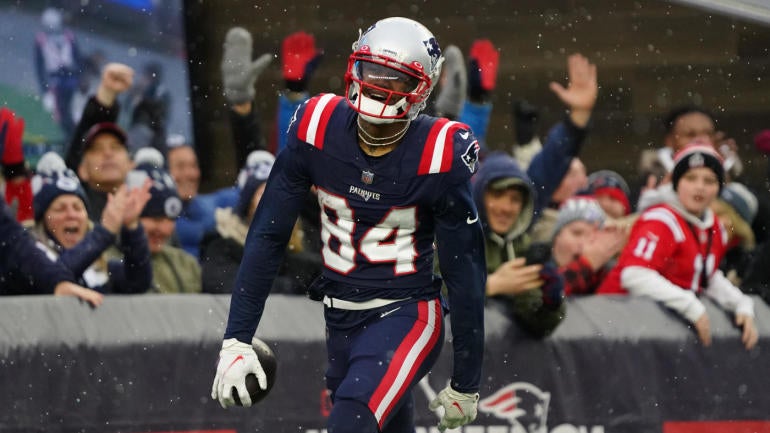
Fantasy Football is all about the matchups. Even though you drafted your team with certain hopes and intentions, your weekly lineup decisions shouldn't be determined by the order you picked your players in. You need to check who your players play and make sure you've got the right guys in -- and the wrong guys out.
It's too early to be absolutely sure on which matchups will be easy and which ones will be tough, but we can take some educated guesses based on healthy personnel, defensive schemes, track records and key details of offenses. The things we know can help us minimize the impact of the things we don't know. This should lead to better decisions being made.
We'll go through every game and highlight the players who aren't obvious starts and sits (because you don't need to be told to start Justin Jefferson). You should feel more comfortable starting or sitting players based on the information given, and feeling comfortable with your Fantasy lineup before the games start is the best feeling in the world.
It's also important to have a keen eye for matchups dictated by the remaining schedule. I am now updating my projected Strength of Schedule rankings our broken down by position available on SportsLine. My objective is to break down how the schedule affects every Fantasy relevant player for the upcoming four weeks, the playoff stretch and the entire season. You'll also be able to find my key takeaways on which players you should buy low, sell high and more trade advice.
White had just his second game this season with over 15 PPR points (15.9 for you decimal junkies) and he needed an abnormal amount of catches to get there. Buffalo's run defense seems to be improving, though they may not get truly tested until Week 11 or 12. White sadly continues to be the rare running back who sees over 15 touches each week but doesn't get enough with them. I'd rather start Darrell Henderson, Alexander Mattison and D'Onta Foreman.
| ||||||||||||||||||
LAST WEEK: White was saved by receptions, grabbing all six of his targets for 65 yards including two that traveled at least 20 yards. It was a career-high in yardage and a season-high in receptions. As a runner, he ran between the tackles on 92.3% of his 13 carries, had one rush go for more than 5 yards -- and seven for two or fewer yards.
THIS SEASON: Among the 36 running backs with at least 50 carries, White ranks 31st in yards per carry (3.2), 31st in yards after contact (2.35), 31st in five-yard run rate (28.9%), 32nd in rushing Expected Points Added (EPA) with minus-0.23, 32nd in yards before contact (0.86), 32nd in explosive run rate (3.6% of his runs have traveled 12-plus yards) and 33rd in success rate. And he's ninth in percentage of carries up the middle (59%), which means his own team isn't even trying that hard to find better ways to use him as a runner -- they're just letting him pound his pads between the tackles.
UP THE MIDDLE: Buffalo is allowing 3.1 yards per carry to RBs on attempts up the middle this season, fifth-best in football.
BILLS: Rank poorly in yards per carry allowed (4.9, that's fourth-highest), yards after contact per rush (4.08, that's dead-last) and missed tackles (37th, which is third-worst). However, they are trending in the right direction over their past two games against the Giants and Patriots (3.5 yards per carry, 2.71 yards after contact per rush, seven missed tackles). Middle linebacker Terrel Bernard has been a key figure in the unit, veteran Tyrel Dodson hopes to build off a great Week 7, and defensive tackle Ed Oliver has a chance to play after missing last week.
AGAINST THE PASS: Despite holding RBs to a nice 72% catch rate, the Bills are fifth-worst in yards per catch given up to running backs at 8.4. However, they are trending in the right direction over their past two games against the Giants and Patriots (5.6 yards per catch). And only two running backs have over 40 yards receiving against Buffalo in 2023.
CHASE EDMONDS: Veteran passing-downs back could be activated for the game and might see work in some passing situations.
Davis is basically a weekly flex starter because of his upside as a deep-ball target in a Josh Allen-led offense. But it's nice to know the Buccaneers have been susceptible to deep throws and deep touchdowns this season. I would roll with Tee Higgins, Josh Palmer or Courtland Sutton over him, but low-upside receivers like Diontae Johnson, Marquise Brown and DeAndre Hopkins don't come close to Davis' upside.
| ||||||||||||||||||
LAST WEEK: Of his five targets, four were uncatchable and three of those were deep lobs. Two of the five were thrown while Davis was in the end zone. The Patriots got physical with Davis and it disrupted his timing.
END ZONE: Davis is tied for fourth among all receivers with seven end-zone targets. Three were converted into touchdowns; he has another score that was thrown from the 35-yard line down to right in front of the end zone.
DEEP BALL: Davis has 17 targets of 15-plus Air Yards this year. He's caught nine for 27.1 yards per grab including three touchdowns. That puts him 12th among all wideouts in deep targets but 40th in catch rate (53%).
BUCCANEERS: Have allowed a 50% catch rate on wide receiver targets 15-plus Air Yards downfield, which is bottom-10. But they're right around league average in Yards After Catch per reception (YAC/reception) at 4.60, and four of the five touchdowns they've allowed to receivers this year have come on deep throws. Strong safety Ryan Neal has had an up-close view on three of those four.
The Buccaneers play more than a decent amount of zone coverage and like to blitz the quarterback, a combination that should help Kincaid continue to get fed short-area targets. But even with Knox gone, Kincaid feels a little unlikely to score because of how the Bucs have done this year against tight ends. That doesn't mean he can do some damage on six or seven targets, a bankable number if only because Knox is sidelined. Kincaid's worth starting as a low-end TE over pretty much anyone you've plucked off waivers this year, including Dalton Schultz in half and full PPR leagues.
| ||||||||||||||||||
LAST WEEK: The Patriots mixed and matched their pass defense schemes, but when they went to zone coverage it compelled Allen to throw short passes to Kincaid. That led to his career-high numbers in targets (eight), catches (eight) and yards (75).
FILM: Nearly all of Kincaid's catches were on out or hitch routes, but none were deep and only a couple had some meaningful yards after catch. He struggled with physicality in coverage which might explain why he rarely saw targets against man coverage in this game or this season. The flip side to that is his ability to move well in space to beat zone coverage. Only two of his targets came in Patriots territory and only one came in the red zone.
McDERMOTT: The Bills coach said after last week's game that "we've got to continue" to get Kincaid targets.
THIS SEASON: Kincaid has one end-zone target. Dawson Knox has four. Knox is not playing this week due to a wrist injury, so perhaps some possible end-zone looks can flow Kincaid's way.
KINCAID: Has lined up as a slot receiver on 45% of his snaps and out wide on 22% of his snaps; he is not used like a traditional tight end.
BUCCANEERS: Have been pretty good against tight ends when they're lined up in the slot or out wide, letting up a 61% catch rate (that's top-10) and 9.8 yards per catch with 3.86 YAC/reception. They have yet to allow a touchdown to a tight end no matter where they've lined up, and they've tussled with T.J. Hockenson, Cole Kmet, Dallas Goedert, Sam LaPorta and the Falcons' wonder twins. Only Hockenson had over 10 PPR points.
Don't be surprised to see Singletary work his way into the Texans' snap share lead again this week, but also don't be surprised if it's close. Pierce's best shot at his third game over 10 PPR points is to score, while Singletary could pull down enough work to get there without the touchdown in PPR. I'd be nervous to start either running back because they could take work away from each other but if I'm going off of film and how they've done this year, Singletary stands out. I'd start him over Emari Demercado, Jaleel McLaughlin and Royce Freeman.
|
WEEK 6: Pierce started but he and Singletary not only alternated who started each drive but would replace each other regularly in drives the other started. Around the middle of the second quarter it began to feel like Singletary was starting to play more, ripping off runs on five consecutive plays at one point. Over those final three quarters Singletary played 21 snaps to Pierce's 15 and had 39 total yards on 10 touches to Pierce's 20 total yards on his 10 touches. Overall, Singletary led the backfield in snaps for the first time this season with a 53% share to Pierce's 33%. Stunningly, Mike Boone handled a bunch of third-and-long snaps.
FILM PART 1: The numbers looked gross for a reason: The Texans offensive line was still very much an issue as only tackle Laremy Tunsil and guard Shaq Mason were remotely consistent as run blockers. There were too many times, both against the Saints and in general this year, when the running backs had no shot to gain any yardage because blockers whiffed, got pushed backward or got pushed down to the ground.
FILM PART 2: It was clear to me that Singletary was the better back in Week 6 -- he was patient, ran with very good vision and agility, and knew well enough to follow his blocks and skillfully maximize his runs. He also was used in a versatile way, frequently lining up wide. Pierce was pretty much a grinder and didn't do much to try and make defenders miss him. He was a little slow to react to his blocking, even when it was pretty good. It's almost as if Pierce wasn't quick enough to take advantage of the 1.5 seconds his O-line could hold a block, but Singletary was.
GOAL LINE: The Texans gave Pierce three carries from the 1, the 2 and the 5, and he lost seven yards combined on those plays. The goal-line role might not be his coming out of the bye. On the season Pierce has six carries inside the five with one touchdown. Singletary has zero carries from inside the five. That could change.
DEMECO RYANS: Said after their last game that they Texans will "continue to balance those two guys out." And this week when he was asked about the run game he mentioned Pierce and Singletary as a duo. Neither one is going away.
SCHEME: Not only was Singletary better than Pierce overall (4.8 yards per carry to Pierce's 2.6), but he ran the zone-scheme runs the Texans seem to prefer at a much better rate than Pierce. Singletary was also considerably better on power-gap runs.
PANTHERS: Lead the NFL in rush touchdowns allowed with 11 and are bottom-three in yards per carry allowed (5.3), defensive rush EPA (-28.57, that's absurd), yards per contact allowed (1.89) and rush-to-touchdown ratio (13.8 rushes per score). They're also bottom five in yards after contact per rush (3.41 yards!) and seventh-worst in missed tackles. But other than that they're good!
It's a little tricky to trust Schultz with Dell back, but the hope is that the combination of Schultz's matchup and the trust he's gained with Stroud will lead to modest numbers including, hopefully, a touchdown. It also helps that the Texans have struggled to run the ball, so extra chances to pick up short targets could make a difference. I would start Kincaid over Schultz in half- and full-PPR, but not non-PPR. I would also start Schultz over Jonnu Smith and definitely over Taysom Hill.
| ||||||||||||||||||
PAST TWO GAMES: Led the Texans in targets (17), catches (11), yards (126) and touchdowns (two). It's notable as Texans rookie speedster Nathaniel Dell didn't play in Week 6 and missed the second half of Week 5.
DEEP TARGET: In the six quarters Dell missed Schultz was used much more as a downfield threat -- and succeeding. On throws of 10-plus Air Yards Schultz caught 3 of 6 throws for 61 yards and a touchdown. Before Week 5 he saw one target of 10-plus Air Yards including zero in Weeks 3 and 4.
FILM: I've seen a version of Schultz that feels much more interesting than what I remember with the Cowboys. No doubt he was a reliable check-down and short-area guy for C.J. Stroud when Dell was healthy in Week 5. But the moment Dell left the field, Schultz was used on anticipatory/timing routes with Stroud, including a phenomenal sluggo route the Falcons secondary bit on for an 18-yard touchdown. Stroud also leaned heavily on Schultz in Week 6 against the Saints with two targets into the end zone from close range (Schultz caught one). Schultz's speed isn't anything special but he still has ways of getting open against single coverage because of his route running, and Stroud definitely took notice of it.
DELL EFFECT? In six quarters without Dell, Schultz had a legendary 39% target per route run rate and caught 8 of 14 targets for 109 yards and two touchdowns. In the four games prior with Dell active, Schultz had a meh 14% target per route run rate and caught 10 of 17 targets for 89 yards and one score. And whenever Schultz and Dell have been on the field, Schultz has run a route of 10-plus yards just 14 times on 98 routes. Dell is expected to play in Week 8.
PANTHERS: Starting safety Vonn Bell is a question mark to play, and top tight end cover guy Jeremy Chinn was placed on Injured Reserve. When this squad was healthy they did a nice job limiting tight ends like Kyle Pitts and T.J. Hockenson, but in Week 5 they were wrecked by Sam LaPorta for two touchdowns, then the Dolphins offense (not their tight ends) feasted on them without Bell. Fellow safety Xavier Woods figures to return.
Henderson: Henderson is a low-end starter with bust potential because of not only the matchup but the likely split of work with Freeman and the potential pitfall of not being a good fit for this week's game. However, his impact in the passing game should get him on the field more than Freeman and should lead to more touches and catches. That would especially come in handy if the Rams are trailing late. He's a borderline RB2/RB3 who I would start ahead of the Panthers RBs, Rachaad White and the Texans RBs, as well as Royce Freeman. But I'd take Gus Edwards, Javonte Williams and Alexander Mattison over Henderson in PPR and non-PPR.
| ||||||||||||||||||
LAST WEEK: Henderson and Freeman basically rotated drives in the first half, giving each other breaks during their drives. In the second half it did feel like Henderson got the "hot hand" treatment, perhaps more for his pass blocking than anything else, but it amounted to just six more snaps.
FILM: Both backs were good! Henderson had good burst but definitely suffered from some bad O-line blocking that contributed to his poor rushing average. Freeman was fluid with the ball and had better blocking, which helped his average. Both finished strong on their runs, both had inconsistent vision, both ran to contact more than they could have/should have. Freeman almost exclusively ran outside zone while Henderson ran more power-gap concepts, which the Rams as a team have leaned into more this year than in the past. As for the passing game and pass protection work, Freeman was good but Henderson was a little bit better at both. There's no reason to believe the Rams will bench one or the other based on the film.
LAST WEEK: Freeman averaged 5.3 yards per carry on six outside-zone runs, Henderson had 1.3 yards per carry on four outside-zone runs. Freeman also averaged 5.0 yards per carry on four power-gap runs, Henderson had 3.7 on 10 power-gap runs.
COWBOYS: On the season have been considerably better against power-gap runs (85 rushes, 3.4 yards per carry, 2.18 yards after contact per rush, nine missed tackles, 31.8% rate of runs of five-plus yards allowed, three touchdowns) than zone runs (60 rushes against, 4.2 yards per carry, 2.80 yards after contact per rush, eight missed tackles, 35% rate of runs of five-plus yards allowed, two touchdowns). Specifically against outside zone (Freeman's specialty based on last week), the Cowboys have given up 4.6 yards per carry and five or more yards at a 42.9% rate.
COWBOYS OVERALL: Just three running backs have topped 10 non-PPR points this season -- Christian McCaffrey and Jordan Mason along with James Conner, and only Conner got over 15 PPR points.
Prescott is a total wild-card. He's rarely put up good numbers and the Rams haven't let up good numbers often, so that's cause for concern. His pass protection will be in question and we might have to hope for some damage on the ground to help Prescott topple 20 Fantasy points. He's a low-end QB1 who I'd sit for Jared Goff, Kirk Cousins and Joe Burrow but start over Brock Purdy and Geno Smith.
| ||||||||||||||||||
THIS SEASON: Prescott has had two very good Fantasy outings -- Week 2 against the Jets and his last game at the Chargers. They're the only two games he's totaled two touchdowns in.
RAMS: Have allowed two big Fantasy games to quarterbacks this season -- Anthony Richardson (three total touchdowns) and Jalen Hurts (303 yards, two total touchdowns). Everyone else has posted 15 or fewer Fantasy points including a hobbled Joe Burrow, Brock Purdy, Geno Smith and Kenny Pickett last week.
RUSHING: Prescott has been talking about running more after Week 3 and the Cowboys used Prescott's legs in Week 6 (seven carries, 40 yards). Cowboys offensive coordinator Brian Schottenheimer admitted that was "something that has been missing" but not something the Cowboys want to do unless there's good reason.
GOOD REASON? Richardson, Hurts and Joshua Dobbs each did damage as a runner against the Rams defense, gaining at least 47 rush yards each.
RAMS: Reliably have played zone coverage at the sixth-highest rate in the league. That should continue. L.A. also ranks 10th in pass rush pressure rate on the year (37.7%) and tend to get a lot of pressure whether they blitz (like they did last week) or not (like they did two weeks ago).
COWBOYS O-LINE: Hasn't been the asset we had hoped, giving up a pass rush pressure rate of 33.6% this season. Even when they have Tyron Smith and Zach Martin, they've yielded pressure at least a third of the time.
PRESCOTT: Does tend to throw downfield a little more against zone than man, but that's hurt him in terms of his TD-to-INT rate (0 to 3). He also does throw a little further downfield when he is pressured (9.0 ADOT) but completes more passes when he has time.
If you start Cousins, you're hoping he throws a ton of passes and somehow comes up with two touchdowns and maybe even 300 yards. That's possible, but he's catching the Packers at a time when their defense has been playing up to par and is getting fresh bodies back. The Packers are also desperate for victories after losing two straight to the Raiders and Broncos, though neither loss could be hung on the defense. I'd much rather start Jared Goff, but I would trust Cousins over Dak Prescott if only because his passing volume gives him a chance at some decent Fantasy numbers.
| ||||||||||||||||||
LAST WEEK: Overcame a feisty 49ers pass defense to notch a season-high 378 yards with two touchdowns on 35-of-45 passing. Two plays deserve attention: His interception, and his 60-yard touchdown right before the end of the first half, both of which came on contested catch plays between Jordan Addison and Charvarius Ward. The touchdown made the difference between him scoring 25 Fantasy points and 17 Fantasy points.
VIKINGS: After a Week 6 reprieve they got back to their pass-heavy ways against the 49ers (68.2% pass rate). That's actually their third-lowest pass rate in a game this season! Cousins has attempted at least 44 passes in four of six games this season.
RUN DEFENSE: Are expected to get linebacker DeVondre Campbell back this week, which should greatly improve their run defense even with safety Darnell Savage missing time. D-lineman Devonte Wyatt also is expected to play. This should make for tough sledding for the Vikings run game and thus force the Vikings into doing what they love doing anyway -- throw the football.
PASS DEFENSE: Green Bay is also expected to get Jaire Alexander back at outside cornerback; he hasn't had a shut-down type of season but he's an upgrade over a secondary that struggled at Denver last week (Carrington Valentine allowed an 86% catch rate and 89 yards, the rest of the team gave up 105 yards). He and Rasul Douglas should compel the Packers to blitz more since they're capable of playing well in one-on-one situations.
PACKERS: No quarterback has thrown multiple passing touchdowns against the Packers this season. Only Desmond Ridder has totaled two touchdowns against them (22 Fantasy points in Week 2). It is worth noting that only Justin Fields in Week 1 has thrown more than 32 times against the Packers this season. Green Bay has allowed a 66.5% completion rate but rank top-10 in nearly every other pass defense metric including 10.0 yards per catch allowed, six passing touchdowns allowed and 16 completions of 20-plus yards allowed (that's third-best). The Packers have not played a gauntlet of great quarterbacks; Cousins will be their toughest opponent to-date.
HISTORY: Cousins has not had a good game at Green Bay since a tie in 2018, a matchup so far back into the past that Stefon Diggs was still part of the Vikings (and caught two TDs in that game).
I'd expect the Saints to get physical with Pittman, which in turn should hurt his efficiency. But there's no denying his target volume, even though Minshew has missed him on deep throws. That's what you're hoping for with Pittman -- a lot of catches and some solid yardage with it. That keeps him in the low-end flex range in PPR, but in non-PPR he's too big of a risk. I'd rather start Calvin Ridley, Tyler Lockett and George Pickens in all formats, and Josh Downs in PPR.
| ||||||||||||||||||
LAST WEEK: Had a 22.7% target share, which sounds awesome until you realize Gardner Minshew threw just 23 passes in a high-scoring loss. He didn't see a target until late in the first half when he got open on a red-zone shallow crosser and may have scored if Minshew hadn't thrown late and thrown too high. Another target on what might have been a long catch was intercepted, a second red-zone shallow crosser that should have been a touchdown was thrown high and bobbled, and a deep target against prevent defense at the end of the game was nearly picked off. Alas, Pittman's post route and broken-tackle effort more than salvaged his stat line (2-83-1).
WITH MINSHEW IN 2023: Pittman leads the Colts with a 28.1% target share, eight red-zone targets and two end-zone targets. However, of his 43 targets from Minshew, eight were deemed uncatchable and five of those eight were on deep throws (15-plus Air Yards downfield).
THIS WEEK: Pittman openly questioned his role in the wake of the Colts' loss last week, saying "maybe I'm not a big part of the offense," then tried to walk his comments back by admitting he lost his composure.
TARGETS: Pittman has averaged 9.3 targets per game this season and 10.0 targets per game in Weeks 3, 6 and 7 when Minshew started at QB. Pittman also has played mostly as an outside receiver in those three games.
SAINTS: Have allowed the sixth-lowest catch rate to wideouts this year (57.2%) and are about league average in yards per catch allowed (12.0). Drill down into how they've done specifically against outside receivers and the news gets worse: a 50.6% catch rate allowed with about the same receiving average (12.2) to go with a league-average 3.9 YAC/reception allowed.
MATCHUP: The Saints like to play a lot of man coverage and are among the league leaders in pressing receivers after the snap.
PITTMAN: With Minshew, he has averaged way more YAC/reception against man coverage (10.13) than zone (4.29), sees a deeper ADOT against man (9.3) than zone (7.8) but does have a lower catch rate (61.5% versus 70%) and lower target per route run rate (20.6% versus 26.3%). It gets worse when he's pressed -- his YAC/reception is 5.0, his ADOT is 8.6, his catch rate is just 45.5% and he has yet to score or create an explosive play.
Bourne lined up wide much more last week, but his role didn't change. That's especially encouraging with JuJu Smith-Schuster potentially coming back and working into the slot more. Bourne should stick in the offense, and the offense should be at least in a competitive matchup and at worst chasing points, which means either way Bourne should see some good target volume. It still feels risky to use Bourne, even as a PPR flex, but he's got a better profile as a top-target earner this week than Michael Thomas, Christian Watson and Jerry Jeudy.
| ||||||||||||||||||
LAST WEEK: Bourne remained a huge part of the Patriots offense, catching 6 of 7 targets for 63 yards with a touchdown in the team's upset win over the Bills. His lone missed target was laughably thrown behind him on a behind-the-line screen pass. It's also worth noting that Bourne lined up wide on 79% of his snaps, a huge change from the week before (58% in the slot).
FILM: Bourne continued to run short routes but the details in which he ran them continued to be excellent. He used pace and spacing as ways to buy him time and steps on defenders before and after the catch, and he ran with more physicality -- both improvements from last week's game. He had good timing with Mac Jones on an out route and on a hitch and simply worked as his most reliable option in the passing game.
LAST TWO GAMES: Bourne has cleaned up in the receptions game, tallying 16 receptions on 18 targets for 152 yards (just 9.5 yards per catch) on a minuscule ADOT (1.94 yards) and the score. But it's working as the Patriots have been much improved offensively. The next-best non-running back in targets over the past two weeks? Demario Douglas and Hunter Henry, tied with six each (Douglas only played one game).
WEEK 2: The Dolphins were outstanding covering all of the Patriots' receivers, including Bourne, who had nine targets but caught only four for 29 yards. New England used Bourne differently then -- he had a 20.4 ADOT and saw four deep lobs from Jones, two of which were uncatchable.
DOLPHINS: See the seventh-most targets to opposing wide receivers and give up a catch rate of 70.6% to them. But they're actually fifth-best in yards per catch allowed (11.2) and just below league-average in YAC/reception allowed (4.06). Over the past month they've missed more tackles versus wideouts (12) than any other team, including on the short red-zone throw to A.J. Brown last week.
Wilson remains one of the most unfortunate souls in the NFL -- he's got incredible talent but is saddled with a quarterback who has struggled to consistently locate him. Tack on the blitz-happy Giants and there's worry Wilson won't even hit 15 PPR points, and almost certainly doesn't have the upside of a top-20 receiver. In PPR I'd rather start Terry McLaurin, Nico Collins and Drake London, but I would start Wilson ahead of Zay Flowers, Marquise Brown and Christian Watson ... but I'd rather start those three in non-PPR.
| ||||||||||||||||||
THIS SEASON: Ranks in the top-20 among receivers in targets per game (9.2) as well as top-10 in team target share (32.5%, that's huge) red-zone targets (11, second-most among wide receivers). Everything else -- from yards per catch (11.5) to explosive play rate (7.3%) to YAC/reception (3.84) are all outside of the top-30. It's those targets, and the catches that have come with them, that have mostly buoyed his Fantasy average at 13.5 in PPR (he's at 8.2 in non-PPR).
GIANTS: Figure to keep their blitz-heavy mindset against the Jets and their depleted offensive line. It's what the G-Men did last week against pressure-sensitive QB Sam Howell and it kept the Commanders from putting up a lot of points (McLaurin did have 15 PPR points). The Giants have landed pressure on at least 40% of their defensive snaps in five of their past six games.
PRESSURE: Zach Wilson has completed 43.5% of his throws for 4.5 yards per attempt with no touchdowns, one interception and a QB Rating of 50.4 when pressured this season. Garrett Wilson has a catch rate of 28.6% on the 14 targets he's seen when his QB has been pressured this year. Eight of the 14 targets were deemed uncatchable.
MORE BAD NEWS: Of the 55 targets Garrett Wilson has seen overall from Zach Wilson, 17 have been deemed uncatchable. That's 31%. That's almost one out of every three throws. Even 6 of his 17 targets in his past two games were uncatchable. Jeepers.
GIANTS: Have begun settling down against wide receivers over their past four games (Seattle, Miami, Buffalo, Washington), letting up a 67% catch rate but only 11.4 yards per catch (ninth-best). Their YAC/reception allowed is a nasty 5.46 yards but that's weighted by the Dolphins 198 yards after the catch in their Week 5 showdown. Outside cornerback Tre Hawkins has started to play better over the last two games and fellow rookie Deonte Banks is slowly starting to show signs of being capable.
Ridley's been frustrating for Fantasy managers to deal with, made worse by the Jaguars' lack of creativity in how to use him more effectively against the kinds of defense he's seen. If he was in motion more often he'd get more free releases and would be able to get open for Lawrence. Until there's evidence of that happening, it's OK to be more nervous than optimistic about Ridley, especially against a fierce defense that has done (relatively) well taking away a team's most dangerous receiving threat. I'd rather start Drake London and George Pickens in all formats, Tyler Lockett and Brandon Aiyuk in non-PPR, and Garrett Wilson and Chris Godwin in PPR.
| ||||||||||||||||||
LAST WEEK: Faced a lot of physical coverage -- and not just by Marshon Lattimore. Both of the Saints' outside cornerbacks took turns getting hands on Ridley and disrupting his timing. And if that wasn't enough, the Saints didn't play as much man coverage as they had prior and did frequently put a safety over the top on Ridley's side of the field to further deter targets going his way. That paired with Trevor Lawrence trying to get rid of the ball quickly made for a cardio-filled night for Ridley as he had just four targets and one measly catch.
FILM: There's bad and there's good. Yes, Ridley struggled with press coverage. But no, he wasn't always locked down. Ridley did win multiple battles with his coverage but wasn't quick enough to get open on his longer routes for Lawrence to locate him. That changed in the fourth quarter when he had two deep fade targets from Lawrence -- one that looked like a clutch 26-yard reception but it didn't count, and another where he was blanketed. If he ran shorter routes, or if Lawrence had more time to throw, he would have had more targets for sure. Reality? Heavy coverage to his side of the field opened things up for his teammates.
STEELERS: Played zone coverage at a league-average rate in their first two weeks but have made the heel turn to playing the third-most man coverage over their past four games including near-even snaps between man and zone coverages against the Ravens and Rams.
PRESS COVERAGE: Ridley has a 14.2 target per route run rate and a 44.4% catch rate when pressed (defenders get their hands on him off the snap), and he's been pressed on just over half of his routes this season. The Steelers have pressed outside receivers (like Ridley) the fifth-most times of every defense.
JAGUARS: Haven't seen a lot of man coverage against them this season, including last week against the Saints. When they have, Lawrence has completed under 60% of his passes with a 20.6% off-target rate and a QB Rating of 79.9. It's decidedly the kind of coverage that would rattle him. As for Ridley, he's only seen six targets against man coverage this season, catching four passes for 80 yards, the longest of which was 32 yards on a deep fade against Buffalo.
WIDE RECEIVERS: Four have posted at least 20 PPR points against the Steelers this season, and the list is interesting: Brandon Aiyuk (but Deebo Samuel had 11.3 PPR points), Davante Adams (but Jakobi Meyers had 15.5 PPR points), Nico Collins (but Tank Dell had 2.6 PPR points), and Puka Nacua last week (but Cooper Kupp had 4.9 PPR points -- and two drops). Aiyuk crushed man coverage, Adams crushed everything but scored twice versus man, Collins did the same (one TD versus man coverage) and Nacua had 58 of his 154 yards after the catch against man coverage.
If you start Harris, you're hoping he scores for the second straight week. Otherwise, expect what he did before Week 7 -- below 12 PPR points, if not below 10. Against this tough matchup that has proven to be outstanding at the specific type of run scheme Harris does best in, I would rather start Gus Edwards, Darrell Henderson and Dameon Pierce in all formats as well as Jaylen Warren in PPR.
| ||||||||||||||||||
LAST WEEK: Found the end zone at long last but otherwise looked mostly like the guy we saw before the Steelers' bye. He does deserve credit for avoiding seven tackles, but two came on a play he lost yards on and another on a four-yard catch. His longest run came on a fourth-quarter scoot for 10 yards. He had 17 touches and maintained his role as the lead running back for the Steelers including near the goal line; Jaylen Warren played all but two of the team's 14 third and fourth downs.
O-LINE: It's never an easy day when you have to (try to) block Aaron Donald, but the Steelers offensive line, save for center Mason Cole, received high marks from Pro Football Focus for their run blocking in Week 7. That's important since two linemen -- Dan Moore and James Daniels -- returned to action. Moore was much better in power-gap schemes, Daniels in zone-run schemes.
HARRIS: Has fared better running zone (4.0 yards per carry) than power-gap (3.5 yards per carry). Warren is the opposite - he's getting 4.7 yards per carry on power-gap runs and 3.4 in zone-scheme runs.
JAGUARS: May have struggled to keep Kamara from beating them through the air but kept him to 3.6 yards per carry last week. That number is actually a shade higher than the 3.4 they've let up to opposing running backs all season. But so much of that has been because they've been great against zone runs -- 2.7 yards per carry allowed with outrageously good numbers before and after contact. Against power-gap runs they're allowing 4.2 yards per carry, which isn't awful, but they're getting beat for 1.97 yards before contact per rush, which ranks fourth-worst. For this week, the stat hurts Harris since he's been more effective running zone.
This is a good matchup for London given how receivers have done. He's regularly been toward the top of the target count for the Falcons every week, and the bonus of a tough run defense matchup for Atlanta's ground game could help Ridder throw as many as 30 passes. I don't mind London as a low-end WR2 ahead of Calvin Ridley, Chris Godwin and Garrett Wilson.
| ||||||||||||||||||
LAST WEEK: Hit 11.4 PPR points (6-54-0 on seven targets), which technically was a four-week low but also his third game in six weeks with under 13 PPR points. His ADOT cratered from 11.0 yards or more in each of his previous three games to 5.14 in Week 7.
FILM: Nearly had two touchdowns -- one on a jump ball that Bucs defender Antoine Winfield Jr. made a clean play on, another on a red-zone catch-and-run where he was stopped by Winfield just before he reached for the pylon. The myriad of short routes he ran were frustrating given the opponent and the pass-game opportunities but he still flashed good speed and had good timing on a number of throws from Desmond Ridder. He seems to be the Falcons' most consistent receiver, though I must add that Kyle Pitts continues to look better and better each week, and he's running downfield more often than London.
TITANS: Allow the third-highest catch rate to outside receivers (like London) at 75.6%, but have done a nice job containing them (12.1 yards per catch is sixth-best, 3.56 YAC/reception is better than league average). Four of five touchdowns let up by the Titans have gone to outside guys as well. Nonetheless, they've allowed at least 14 PPR points to at least one receiver in every game this year, and it's usually been an outside receiver (like London).
TRADE: Tennessee dealt safety Kevin Byard to the Eagles this week and replaced him with Terrell Edmunds. Not that Byard has been outstanding in coverage, but he's savvy and knows where to be and helped guide his teammates. Edmunds has been worse in coverage and doesn't have any experience playing in the Titans system, obviously. It should be one of those little things that helps make a matchup even sweeter.
After starting the week interested in Howell because of his anticipated pass attempts, I've backed off. I am nervous about trusting not only him but the Commanders playcalling to find answers against an Eagles defense that should deliver pressure even without blitzing and just improved its secondary. After all, the DOLPHINS were stymied by the Eagles defense last week. I know the Commanders have played the Eagles close in recent years but I can't trust Howell on a week when no one is on bye. I've relented and will now start Jordan Love, Derek Carr and Jimmy Garoppolo over Howell.
|
LAST WEEK: Howell was pressured on 40.8% of his dropbacks and completed 52.4% of his passes against an improving-but-not-dominant Giants defense. They were aggressive with their blitzing from the jump (Howell was sacked on the second play of the game and four more times after). New York blitzed on 63.3% of their snaps.
FILM: The playcalling was Howell's biggest problem last week as it took the Commanders nearly a half to finally call plays that adjusted to what the Giants were doing. To wit, Howell was 5 of 14 for 60 yards with five sacks in the first half, 17 of 28 for 189 yards and one sack in the second half. Howell also seemed to lack velocity on a bunch of his throws but that could have been due to heavy winds in New Jersey. And Howell helped put the Commanders in position to tie the game late despite the Giants' blitzing but threw a little bit behind Jahan Dotson, who couldn't bring in the throw.
WEEK 4, PART 1: Philadelphia blitzed a decent amount against Howell but were far more judicious with it (34.6% of snaps) than the Giants were last week. And Howell beat the blitz to the tune of 8 of 13 for 62 yards. That's not the surprise -- the surprise is last week's game against the Giants was literally the only game this season Howell didn't have a completion rate of over 60% against the blitz. Howell has been blitzed on 95 of his 313 dropbacks (30.3%) this season and has been fairly decent (just 6.2 yards per attempt and three touchdowns).
PRESSURE: Different than blitzes because it includes any play a defense gets near a quarterback, Howell has completed over 50% of his throws in just two games when pressured for 5.8 yards per attempt and two touchdowns with five interceptions. The Eagles may not be willing to blitz any more than they did in Week 4 and hope for successful results.
EAGLES: Surely will do what they can to bring pressure to disrupt Howell, but Philly is below league-average at both pass rush pressure rate and blitz rate. Of note, they did intensify their blitz rate against the Jets in Week 6 but still didn't improve their pressure rate significantly. The sack totals suggest differently -- Philly has 13 sacks in their past three games including five against the Jets -- but only two came on blitzes.
WEEK 4, PART 2: Howell was having a dud game against Philly until the fourth quarter when he ran a lot more (34 of his 40 rush yards) and found his only touchdown on the game on the last play of regulation. He scored 21 Fantasy points in an overtime loss and had 13 of them in the fourth quarter, eight on the final drive.
HOWELL: Has at least 41 pass attempts in three of his past four games. He went over 20 Fantasy points in two of those games (at Philly, versus Chicago).
I have a gut feeling the Commanders are going to play the Eagles to the wire. Maybe that's because that's what they usually do -- they've lost one game to Philadelphia by more than 10 points in their past nine meetings, all with McLaurin. His track record has to be considered here, but it's the Eagles defense that comes up big from game to game, but not without letting up a lot of receptions along the way. Count on McLaurin as a reliable WR2 over Jaylen Warren, Tee Higgins and Drake London.
| ||||||||||||||||||
WEEK 4: Busted the Eagles pass defense for an 8-86-0 stat line with 10 targets and an offensive fumble recovery for a TD.
HISTORY: McLaurin has scored 22, 20, 16 and 13 PPR points in each of his past four against the Eagles' vaunted defense. He also has been above 15 PPR points in 6 of 9 career games against Philly. Considering the rotation of quarterbacks he's dealt with in those games, it's impressive.
SAM HOWELL: Over the course of the season has had a tendency to target McLaurin when he's pressured -- he has a 22.4% target share in those situations, though the wideout saw one target in that situation last week (he caught it for 31 yards). Naturally, McLaurin also has a team-high 21.3% target share when the QB isn't pressured, but his ADOT is much lower (9.08 versus 16.69) when there's no pressure.
EAGLES: Are actually slightly below league-average in pass rush pressure rate on the season, a weird quick considering their reputation. Week 4 was their second-highest blitz rate against the Commanders and they pressured Howell on 36.5% of his dropbacks. It wasn't enough to slow him down as Howell threw for 290 yards and completed 70.7% of his passes.
EAGLES: Traded for Titans safety Kevin Byard to further help them on the back end of passing plays and help immensely on run plays. Thirteen different enemy receivers have had at least 12 PPR points against the Eagles on the season, and at least one receiver every game has gotten to 16 PPR points. I am not sure Byard will help slow that number down in his very first game.
Cooper's eight targets per game in his past two is tough to overlook, and if Walker throws shorter passes because of the coverage Seattle plays, that should make for some decent catch and yardage totals. I wouldn't expect a huge game by any measure but a 6-75-0 stat line is certainly in play. That puts him near the border of a WR2/WR3 in full PPR -- I'd chance it with him over Josh Palmer, Courtland Sutton and Josh Downs. But in half- and non-PPR I'd head for the hills and take a shot on Palmer, Sutton, Zay Flowers and Rashee Rice over Cooper.
| ||||||||||||||||||
PAST TWO WEEKS: In Week 6 with P.J. Walker starting, Cooper saw eight targets and caught four for 108 yards including two deep connections, one where a defender fell down and Cooper added 35 yards after the catch. In Week 7 with Walker replacing Deshaun Watson early on, Cooper saw eight targets and caught just two for 22 yards. In the two games combined Cooper has seen one red-zone target, no end-zone targets and the Browns have run just five pass plays.
FILM: Cooper looks great -- he remains an outstanding route runner who can stop and turn on a dime. His effort is mostly outstanding when adjusting to an off-target throw, which from Walker there have been many. Last week he had trouble reeling in one pass thrown just behind him, another that was too tall, another that was too low, and one more that was underthrown and ultimately intercepted deep. There wasn't as much of that the week prior against the 49ers, though Cooper still had to adjust to some off-target passes then. I counted five uncatchable targets over the two games (16 targets).
SEAHAWKS: Typically play heavy zone coverage without blitzing much. Their pass rush pressure rate has been great against bad offensive lines and otherwise hit-or-miss. But their style of defense combined with the talented defensive backs on the roster have lef to top-five statuses in yards per catch allowed (9.9) and YAC/reception allowed (4.13, best in football). They also see the eighth-lowest ADOT at 7.29, a byproduct of their zone-heavy scheme. Outside receivers are catching 60.8% of their targets against them, 10th-lowest in the league.
BROWNS: Surprisingly have let up the 10th-highest pass rush pressure rate on the season (38.3%). In Walker's past two games pressure has arrived, on average, at 2.36 seconds, which ranks 10th fastest in that span. That's not so great, but those games were against the Niners and Colts, both of which figure to have better pass rushes than the Seahawks.
WALKER: Over the past two games has completed 61.4% of his throws of 10 or fewer Air Yards with an off-target rate of 4.5% (44 attempts). When he throws 11 or more Air Yards his completion rate nosedives to 27.3% with an off-target rate of 54.5% (22 attempts).
Edwards hardly gets targets and might need a couple of big plays and/or a touchdown to really deliver for Fantasy managers, but he's worth the risk given his increase in playing time and workload near the goal line. Baltmore's offensive line should help pave the way for Edwards to be worth using as at least a low-end RB2, even in PPR. I'd start him over the Steelers RBs, the Broncos RBs and the Rams RBs.
| ||||||||||||||||||
LAST WEEK: In snaps with Lamar Jackson, Edwards played 50% of the time and dominated on snaps inside the 10 (4 of 5). That count was actually LOW for him as he played 61% of the snaps against the Titans with 7 of 8 snaps inside the 10. Edwards has fully taken back the short-yardage/goal-line role from Hill.
RUSHING: What I can't say is that Hill is less efficient than Edwards. Last week Edwards averaged 4.6 yards per rush, tied for his second-best mark of the season. Hill, on 10 fewer carries, had 11.5 yards per tote. Since coming back from injury, Hill has had better rushing metrics than Edwards every single week on fewer opportunities -- and that's a difference-maker.
TOUCHES: Edwards and Hill were very close in touches in Week 5, a game both were moderately efficient in. In the two games since Edwards has twice as many touches -- 30 carries and two catches -- compared to Hill -- 12 carries and four catches.
FILM: Edwards still has some gas in the tank, though it ran out on his 80-yard catch-and-run against the Lions last week. But he's got all the power you'd expect for a guy his size along with a downhill gear that ramps up rather quickly. Hill is faster, there's no doubt, but Edwards is the better overall package as a runner.
CARDINALS: Rank in the bottom-eight in yards per carry (4.5), defensive rush EPA (3.13), runs of 10-plus yards (16), yards before contact allowed (1.67) and missed tackles on runs (35) allowed. They also have given up the fourth-most Fantasy points to running backs on the season with every lead running back they've faced totaling at least 12 PPR points against them. No surprise, they see on average 25.0 RB carries per game.
THE GOAL LINE: Arizona does deserve some credit -- no team has defensed more than 11 RB carries from the 3-yard line of closer, yet Arizona's let up just three touchdowns on those plays. This doesn't mean Edwards can't score on them, it's just that it might not be easy.
15 CARRIES: In the 13 career games Edwards has had 15 or more carries he's had at least 11 non-PPR points eight times. That's not too shabby. All but one running back with at least 15 carries against Arizona this season has had at least 10 non-PPR points.
It remains reasonable to expect a modest floor from Rice, even if Watson ends up coming back. Rice has been trending in the right direction for the past few weeks and should keep working toward becoming the Chiefs' top wide receiver. He's worth trotting out as a WR3 with 12-point PPR potential ahead of Diontae Johnson, Tank Dell and Jerry Jeudy.
| ||||||||||||||||||
LAST WEEK: Increased his snap count up to a season-high 59%, helped by the injury suffered by Justin Watson. He ran more routes than all Chiefs receivers except Marquez Valdes-Scantling. But his target share remained low -- 15% -- though it did lead to a 5-60-1 stat line on six targets. He lined up all over the field but mostly was out wide (58% of snaps).
FILM: Rice was used on shorter throws last week as the Chiefs seemingly tried to negate the Chargers pass rush with a lot of quick throws. That was not the case on his touchdown -- Patrick Mahomes went to Rice as his third read and threw him a perfect floater over two Charges defenders on the back line of the end zone. His 37-yard gainer was much more impressive as Rice found a soft spot in the Chargers defense and was on the same page as Mahomes on a fantastic catch-and-run. The two were just a bit off on a deep corner route in the early fourth quarter. Overall, Rice still isn't a natural in his routes but is making progress and still has good speed, proper vision and a violent nature. And his nose for the end zone is kind of uncanny.
WEEK 6: On a Thursday night game Rice caught all four of his targets for 72 yards against the Broncos. Mahomes attempted 40 passes.
BRONCOS: Stink against the pass. Outside receivers have caught a league-high 76.3% of targets against them with 13.7 yards per catch and six touchdowns. Slot guys are at a 74.2% catch rate with 9.6 yards per catch and three touchdowns.
The 49ers are taking on a tough defense coming off a bye and won't have their stud left tackle at 100 percent. We've already seen what that's meant for Aiyuk's numbers over the past two weeks (under 12 PPR points each game). At least Brock Purdy figures to play -- his accuracy and calmness in the pocket have been assets for the Niners. It's always a risk to downgrade Aiyuk but his ceiling isn't quite as high given the circumstances. I'd rather start Terry McLaurin, Michael Pittman and Courtland Sutton (weather permitting) in PPR. In non-PPR I'd put Aiyuk in the flex range behind McLaurin but ahead of Zay Flowers and Sutton.
| ||||||||||||||||||
49ERS: Essentially have asked Purdy to accurately complete short throws with the hope of the receiver making plays after the catch. As a result, Purdy has posted a league-average ADOT of 7.9 yards this season, boosted a smidge by his pass attempt rate of 22.8% on throws of 15-plus Air Yards. The plan has worked as Purdy ranks second in yards per attempt (8.6) and fifth in Yards After Catch per completion (5.78).
YAC: Christian McCaffrey (8.69 YAC/reception) and Deebo Samuel (8.2 YAC/reception) have been the Niners' best two YAC targets. Aiyuk (3.93 YAC/reception) actually has a lower mark than George Kittle (5.39 YAC/reception). The only game Aiyuk had high YAC totals was Week 6 at Cleveland (47 yards after the catch over four receptions).
DEEP THROWS: Aiyuk has a 14.72 ADOT this season, suggesting he gets plenty of downfield shots.
BENGALS: Tend to tailor their defensive coverages to their opponents' weaknesses and make outstanding second-half adjustments (four passing touchdowns allowed in the second halves of their six games with six interceptions). To that end, the Browns used a ton of man coverage to help them contain the 49ers in Week 6 while the Vikings stuck with more zone coverage in Week 7. But both teams blitzed a ton -- Cleveland on 40% of its snaps, Minnesota on 53.1%. The Bengals have gotten the fifth-most pass rush pressure without having to blitz this season and may not entirely blitz like the Browns and Vikings did but could still pressure Purdy anyway.
The Bears were content with a balanced offensive approach last week and will probably aim for the same this week unless the Chargers put up a ton of points. Even then, Darnell Mooney's five targets and the running back group 10 combined targets last week suggest Kmet isn't a priority target for Bagent. Because he has concerns about his upside with the possibility of meager Fantasy points, you're better off trusting Jonnu Smith, Logan Thomas or Trey McBride this week.
| ||||||||||||||||||
LAST WEEK: Technically ran 24 routes on 29 pass attempts by Tyson Bagent, but he had only 10 routes where he did not block a defender as part of his responsibilities on the play. Even on some of his snaps when he lined up in the slot Kmet would help the left tackle out with a push before running a route. He had as many targets as you did.
FILM: Bagent actually looked great, going through his progressions better than Justin Fields did at some points this season. Bagent usually took his first read and kept things simple. He had a good arm and was off-target on one throw. The only nitpick was that he missed Kmet wide open on one red-zone play that may have resulted in a touchdown.
BAGENT: Updating this from last week: Threw to his tight ends on just 4.7% of his throws in Weeks 6 and 7, and 13.8% of his throws in the preseason. Shepherd University didn't keep track of targets for Bagent's senior year but his best tight end caught 15.5% of his receptions.
CHARGERS: Have given up 11.5 yards per catch to tight ends, sixth-worst in football. However, that is weighted by Travis Kelce's huge game against them in Week 7; before then the Chargers gave up 9.8 yards per catch to tight ends. Kelce was one of two tight ends who caught a touchdown on L.A. this season.
The Bears defense is slowly improving against the pass, but this is a step-up in competition for them and a step-down in competition for the Chargers. It's easy to start Palmer as at least a flex with the upside for him to capture a top-20 finish if his quarterback improves his accuracy and his running backs don't improve their efficiency. I'd roll with Palmer over Courtland Sutton, Josh Downs, DeAndre Hopkins and Zay Flowers.
| ||||||||||||||||||
LAST WEEK: Led the Bolts with 133 yards on five catches against a tough Chiefs defense that prioritized shadowing Keenan Allen.
PAST THREE GAMES: Has a 24.2% target share with at least seven targets per game, more than double what it was when Mike Williams was healthy. His role hasn't changed since the Williams injury as he has worked mostly as an outside receiver, but his ADOT has ticked up to 14.55 (it was 11.9 through the first three games of the season). The more recent ADOT is higher than Keenan Allen's 11.48 but behind Quentin Johnston's ridiculous 21.29.
FILM: Palmer's 60-yard catch was the perfect playcall against a Chiefs Cover-0 blitz, but you could see Palmer's lack of speed on the play, and it's fair to question why he decided to stop running inside the 10-yard line when faster Chiefs defenders got close to him. He might have scored. Palmer made a studly contested catch on a 25-yarder later on to set up a goal-to-go series, then had another late in the game for 19 yards before finishing with a 22-yard catch-and-run on a slant. He's agile with good footwork.
WITHOUT WILLIAMS: In nine games Williams either missed or barely played in since 2021, Palmer has delivered at least 10 PPR points seven times including all three games this season. He's hit 15-plus PPR points four times including last week.
BEARS: Predominantly play zone coverage though they've used more man schemes over the past two weeks -- and they've had better results with it against the Vikings and Raiders. On the season, wideouts who line up on the perimeter have averaged a 63.6% catch rate and 13.1 yards per catch, both slightly below league averages. But in their past two games those numbers tumbled to 58.5% and 8.9 yards per catch. They're getting better, even if they delivered a pathetic 10.9% pass rush pressure rate against the Raiders QBs last week.
This is a step-up in competition both for the Ravens and for Goff. It's hard to imagine the Lions run game clicking at Baltimore, so expect volume for Goff, which doesn't guarantee great stats but it certainly doesn't hurt. It does feel like the Lions are due for a let-down game and this spot feels like it. I'll cautiously start Goff over Derek Carr and Brock Purdy but I would chance it with Jordan Love over him. I'd start him over Kirk Cousins, Dak Prescott and Trevor Lawrence.
| ||||||||||||||||||
LAST WEEK: Fell behind early and had to throw like crazy, only to fall behind even further. His 53 pass attempts were the fourth-most he's had in his career and his highest since 2022. Somehow, despite the pass volume, he didn't throw a single touchdown. Heck, he had just three red-zone pass attempts! The Ravens defense was outstanding.
WITHOUT MONTGOMERY: We've seen three very different games from Goff: a 33-attempt outing against the Falcons where he threw for 243 yards and one touchdown (and dove for another), a 44-attempt game at Tampa Bay that resulted in 353 yards and two scores (a deep bomb to Jameson Williams helped), and last week's stinker. He's definitely throwing it more, and while two games have counted for more than 20 Fantasy points, I kind of wish he'd throw more touchdowns.
RAIDERS: Have allowed just nine passing touchdowns this season, but eight of them came in their first four games. Las Vegas took on Jordan Love, Mac Jones and Tyson Bagent over its past three games, holding them to one total score. Overall they rank in the bottom-10 in completion rate allowed (68.8%) and YAC/reception allowed (5.53), but they've also deterred quarterbacks from throwing deep -- they rank second in ADOT against (6.15 yards) and have seen the fewest percentage of 15-plus Air Yard throws (14%).
RED-ZONE RAIDERS: Eight of the nine touchdowns they've allowed have come in the red zone and their 67.6% completion rate is fourth-worst. All that good stuff about how the Raiders limit deep throws is negated when they're in a space offenses can't possibly throw deep.
![[object Object] Logo](https://sportshub.cbsistatic.com/i/2020/04/22/e9ceb731-8b3f-4c60-98fe-090ab66a2997/screen-shot-2020-04-22-at-11-04-56-am.png)



